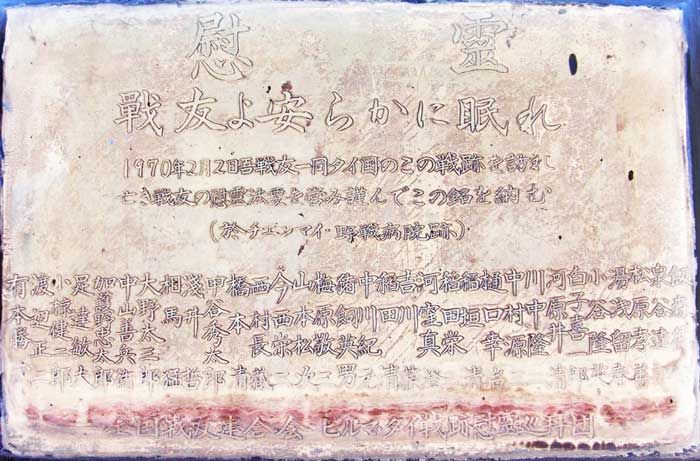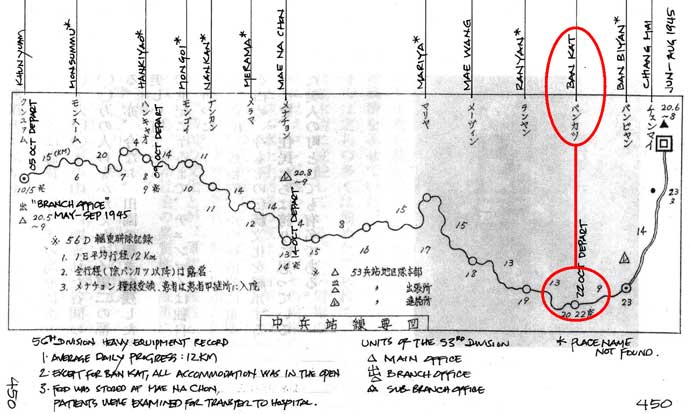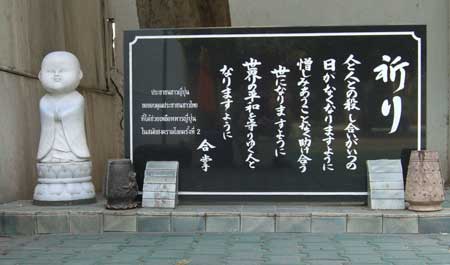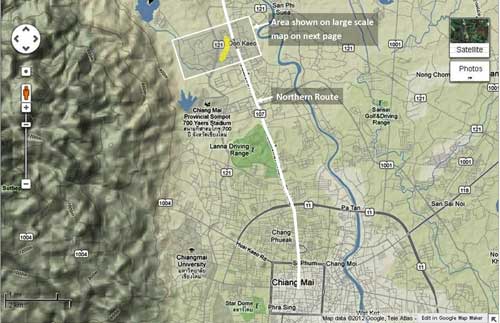First Thai and then IJA troops were assigned at this wat less than a kilometer south of Chiang Mai Gate; the site served as a field hospital in the latter part of the war.1
Wat Muen San and its “companion”, Wat Si Suphan, are located about 0.6 km southwest of the old Chiang Mai City Gate (Pratu Chiang Mai).((Map is from Nations Online Project: Searchable Map and Satellite View of Thailand using Google Earth Data. Annotations are by author.))
Current aerial imagery of Wat Muen San from Google Earth can be supplemented by an Allied aerial photo from 1944. The two are compared below, with key points on the two connected by red lines. The most striking difference between the two is the change in size and location of wat building itself. See aerial overlay below.2
Chiang Mai Point of Interest Plaque No. 34 provides some history of Wat Muen San:3
The English text reads in part:4
[Chiang Mai was founded in 1296.] The existence of Wat Mun San [about half a kilometer south of the town’s south moat] was first recorded in 1438. It was named after a government official with the rank of “mun” (10,000), whose work was concerned with royal documents, or “san”; hence, “mun san”. It appears that in 1522 the monastery was a place where royal documents were being translated and many senior monks lived here. [In 1556, the town was occupied by the Burmese, who in turn were driven out by the Thais in 1775.]
The monastery was renovated in 1799, in the time of King Kawila of Chiang Mai, who brought the population of Ban Ngualai [also Pu and Kong] Community from the west bank of the Salween River to this location [as part of a program to repopulate the area after so many years of conflict]. These people were skilled silversmiths and formed the community “Ban Ngua Lai Mun San” with the monastery as its centre.
World War II
Comparison photos of the front of Wat Muen San, “then and now”:
That on the left was possibly taken during WWII, while that on the right was taken in 2009. The earlier structure, built entirely of wood, burned sometime after the war due to an electrical short.((Date not defined. Replacement structure was funded by a Thai-German couple. Source: Interview with Sing Khom Chai Boonlong, 80+ years old, at the wat, by Jack Eisner and author, 21 Oct 2009.)) The camera position from the old photo cannot be duplicated today because of additional foliage and the construction of a wall and gate. Nonetheless details can be spotted which differ between the two. It is important to note that Thais seem generally not to be concerned with “historically accurate” restorations. In this extract from the 1944 aerial photo following, 2009 structures in the wat are outlined in yellow and the wat can be seen not to be the same size nor in exactly the same location:((The image is an extract from 02486.jpg, taken 03 Apr 1944 by the RAF; source: Williams-Hunt Aerial Photos Collection; ibid. It is overlain on a Google Earth view of the area. Annotations by author.))
 Wat Muen San was one of many facilities in Chiang Mai used by the Imperial Japanese Army (IJA) during the war.7)The wat was first occupied by Royal Thai Army troops; they were later replaced by IJA troops.8
Wat Muen San was one of many facilities in Chiang Mai used by the Imperial Japanese Army (IJA) during the war.7)The wat was first occupied by Royal Thai Army troops; they were later replaced by IJA troops.8
Following its failure to invade British India in mid-1944, the IJA are assumed to have established a field hospital on the grounds to treat incoming war casualties. Located on the southern outskirts of Chiang Mai, the hospital presumably received IJA troops arriving from the south and middle (central) supply routes emanating from Khun Yuam.
A printing press was also located there to print banknotes.9
The IJA apparently also housed POWs at the companion wat, Si Suphan.((Youngest Operative, p 26. )) Boonserm Satrabhaya added detail:
During the war, the Japanese brought English, Australian, and New Zealand prisoners of war to work and drive for them in the Chiang Mai city centre. . . . 46 prisoners-of-war from England, Australia, and New Zealand . . .10
. . . the prisoners of war in Wat Chedi Luang and Wat Muen San . . .11
An interesting tale involving Wat Muen San in the latter stages of the war is recorded by Boonserm Satrabhaya: a young Thai, Orachun Tanaphong, living down the street from Boonserm, became involved in a minor smuggling operation, providing medicine, cigarettes, news, etc to Allied POWs at San Suphan. Following the war, the lad further proved his metal by eventually joining Thailand’s diplomatic corps where he served as an ambassador to several countries.12
A water well figures prominently in a more detailed recounting of the story by Bob Bergin: it served as a drop point for supplies to the POWs.13 That well is visible in the 1944 aerial photo 100+ year old well (as marked above); it looked like this in 2009:14
 Currently, the structure to the left in the photo has been enclosed, further limiting the view of the well. A look down into the well reveals walls with a venerable history:15
Currently, the structure to the left in the photo has been enclosed, further limiting the view of the well. A look down into the well reveals walls with a venerable history:15
Japanese War Memorial Hall
A Japanese War Memorial Hall commemorating fallen IJA veterans lies within the wat compound; Built in 1981,16 it serves as an exhibit hall for both those remembering WWII and for those interested in the history of the wat.((CIMG2892.jpg 16 Mar 2008))
 Ceremonial front of Japanese War Memorial Hall with memorial stele17
Ceremonial front of Japanese War Memorial Hall with memorial stele17
 The stele records twodates when veterans visited the area and conducted commemorative services: 1970 and 1980.
The stele records twodates when veterans visited the area and conducted commemorative services: 1970 and 1980.

Top plaque on stele:18

A somewhat more legible view of the plaque
Translation:
To our veterans: please rest in peace
On 02 February 1970, we veterans visited this field hospital site in Chiang Mai, held a memorial service for our veterans, and donated this monument.
[Contributors’ names]
Veterans’ Federation in Japan / Burma-Thailand Battlefield Site Memorial Group19

A newer column adjacent to the stele looks to the future, multilingually hoping:22)
May Peace Prevail on Earth
Comment
There is little information about Wat Muen San in literature thus far searched.
Two primary sources in this general (website) effort have been:
戦没者遺骨収集の記録 ピルマ・インド・タイ (東京: 全ビルマ戦友団体連絡協議会, 1980) [Journal on Collection of Japanese War Dead: Burma, India, Thailand (Tokyo: All Burma Comrades Organization, 1980)]
戦史叢書 (東京: 防衛庁防衛研修所戦史室 (編集), 1966-1979年) [Senshi Sosho, (Tokyo: Defense Agency, National Defense College Military History Room, 1966‑1979)]
Neither makes any reference to Wat Muen San.23
Exhibits about the IJA at the Memorial Hall are interesting, but offer nothing about the part played by the wat during the war.
Ongoing activities at the Japanese War Memorial Hall
Services at the Memorial Hall in Wat Muen San have been conducted annually on 15 August since 1995.
Here, in 2012, attendees listen as a brief memorial observance from Tokyo is broadcast via the Internet at noon, Tokyo time (1000 hours in Chiang Mai):24
 They commemorate not only the end of a calamitous World War II, but also the beginning of a concerted positive effort towards cultivating world peace. Those services are sponsored by Dr Masanao Umebayashi, a retired soil scientist, and they are an integral part of his own personal effort to make a meaningful contribution to world peace: applying his agricultural knowledge, he has implemented and maintained a program for cultivating fruit trees amongst Thai hilltribe peoples since 1995.25
They commemorate not only the end of a calamitous World War II, but also the beginning of a concerted positive effort towards cultivating world peace. Those services are sponsored by Dr Masanao Umebayashi, a retired soil scientist, and they are an integral part of his own personal effort to make a meaningful contribution to world peace: applying his agricultural knowledge, he has implemented and maintained a program for cultivating fruit trees amongst Thai hilltribe peoples since 1995.25

Until this year (2012), his chosen tree was the manao,26 whose fruit, a type of lemon (or lime), has proven very marketable. Incidentally, and with some humor, to avoid possible difficulties with his Japanese name in a Thai environment, he shortened his first name, Masanao, to Manao, and locally adopted the name, Dr Manao — a modern day Johnny Appleseed.27
This year, he changed his chosen tree to a dwarf coconut palm.28 On 08 July 2012, he oversaw Lions’ Club contributors, local and Japanese, planting young trees at Ban Khuean Phak School:29

 The tree-planting effort continued under his aegis on some steep slopes in the Queen Sirikit Botanical Garden in the afternoon.31
The tree-planting effort continued under his aegis on some steep slopes in the Queen Sirikit Botanical Garden in the afternoon.31
Getting there
[google map here]
To Do List
| 1 | |
| 2 | |
| 3 | Translate Thai articles 20090921/IJA hall text 02a CIMG4928.jpg; & 02b 20090921/IJA hall text 02c CIMG4930.jpg ตำนาน “เสือเยน” (Legendary “Tiger Yen”) 20090921/IJA hall text 04 CIMG4938.jpg |
| 4 | |
| 5 | Was the “silver wat” in WMS possibly funded by a Japanese group? Another source mentions a ‘Thai-German’ couple |
| 6 | Locate info plaque no 34 (fn 4) |
| 7 | |
| 8 | Continue interview with Sing Khom Chai Boonlong at WMS; query others at silver shops around wat for potential interviewees. |
| 9 | Identify contributors’ organizations listed on 1970 plaque. |
| 10 | |
| 11 | Field verify location of Ban Khuean Phak School. |
| First published on Internet | ||
Last Updated on 29 February 2024
- GPS fix on front of Japanese Memorial Hall: N18°46.63 E98°59.10. Wat is 0.4 km east of Road 0108a Station 000.5 near intersection of Wua Lai Road and Wua Lai 3 marked by the cattle statue. [↩]
- The upper image is from Google Earth dated 27 Jan 2010 and accessed 29 Jul 2012. The lower image is an extract from 02486.jpg, taken 03 Apr 1944 by the RAF; source: Williams-Hunt Aerial Photos Collection; original from the School of Oriental and African Studies (SOAS), University of London Digital Data from Center for Southeast Asia Studies (CSEAS), Kyoto University; Digital Archive from Chulachomklao Royal Military Academy (CRMA), Thailand. Extraneous lines and circles link key features, common to both images, for alignment purposes. Annotations are by author. [↩]
- CIMG4965a.jpg 23 Sep 2009. The plaque could not be located in Aug 2012. [↩]
- Text below is edited. Additional historical information is available at:
History of Wa Lai Village
History of Wat Muen Sarn
Wat Muen Sarn in the Past
History of Sutthajitto Art Gallery Cultural insight: Identity crisis in Citylife, Chiang Mai, 18:8 (Aug 2009) [Bracketed text was obtained from these sources.] Note: the location of Ban Ngualai in Burma seems to have been lost. Conversely, the information plaque at the cattle statuary shelter indicates that King Kawila brought the people from Ban Wua Lai in Burma. That the name was transferred from Burma is noted as common in: Grabowsky, Volker, “Forced resettlement campaigns in northern Thailand during the early Bangkok Period”, Journal of Siam Society, 87.1 & 2 (1999) p 61 col 2. [↩] - Photo on exhibit at Japanese Memorial Hall. CIMG4918a.jpg, 23 Sep 2009 [↩]
- CIMG4889a.jpg 23 Sep 2009 [↩]
- In addition to Wat Muen San, there were also other wats: Chedi Luang, Buddha Sattan School, Meaunkong, and Muang Man. Thai soldiers stayed at Wat Chai Pra Kiat. สีงคมดมืองดชียงใหม่ ดล่ม 2 (เชียงใหมี, สะป๊ะดชื่อง ตะงา) (เชียงใหม่: พิมพ์ที่ ใรงพิมพ์ ครองช่าง เชียงใหม่, 2549) [Stories from Chiang Mai’s Past (Chiang Mai: Krong Chang Printing, 2006)] (hereinafter Chiang Mai’s Past), p 51. Bob Bergin specifies the IJA used temples and schools, attributing this to a belief that Allied aircraft would not harm them (“The Youngest Operative“, Studies in Intelligence, 52:3 (hereafter Youngest Operative), p 26). While certainly contributory in that decision, buildings in temple and school complexes were also simply larger and of better construction than other structures, and could thus provide better quality shelter for large numbers of troops and equipment. [↩]
- Interview with Sing Khom Chai Boonlong, ibid. This source also states that POWs were housed at Wat Muen San; this contradicts Bob Bergin’s finding that POWs in the area were housed at Wat Sri Suphan. Bergin’s finding was however supported by an old constructionman in Wat Sri Suphan: he said 10-20 POWs had been housed in Wat Sri Suphan. Source: informal interview with unidentified worker at the wat, 13 Sep 2009, by Bob Edgar and author. To add to the puzzle, the old constructionman identified the 10-20 POWs as Dutchmen from Indonesia. Countering that recollection, a year after the war ended, Great Britain awarded Orachun Tanaphong and family a plaque in appreciation of their efforts to assist Allied POWs in Chiang Mai. [↩]
- Respect paid to fallen Japanese soldiers from WWII, in Chiangmai Mail, III:34 (21-27 Aug 2004). The field hospital function is specifically noted in a dedication plaque at the site. [↩]
- บุญเสิม สาตราภัย เชียงใหม่กับภัยทางอากาศ (กรุงเทพฯ: วิญฌูชน, 2003), Boonserm Satrabhaya Chiang Mai and the Air War (Bangkok: Winyuchon, 2003) (hereinafter, CNX & the Air War), pp 117, 118. [↩]
- ibid, p 118. Confusing, but accurate: a drop point for supplies smuggled to POWs housed at Wat Si Suphan was at a well in Wat Muen San. Youngest Operative clarifies, p 27. [↩]
- CNX & the Air War, p 117. [↩]
- Youngest Operative, pp 25-28. [↩]
- CIMG4847a.jpg 13 Sep 2009 [↩]
- CIMG4732a.jpg 21 Aug 2009 [↩]
- Source required. This date may be related only to the memorial stele in front of the Memorial Building (actually the stele is dated 1980, not 1981) rather than the building itself.
e-Citylife Chiang Mai, 14:10, Oct 2005 recalled in “10 Years Ago This Month” (but actually 12 years before, in 1993):
“In Wat [Muen San] on Wua Lai Road, (half way down on the left) there is a small shrine left behind by Japanese who were billeted at the temple (used as hospital), [the] shrine probably in memory of those who died. Wrote Isao Sakamoto, Japanese Consul in Chiang Mai.”
Conclusions to be drawn here are that:
1. The Memorial Hall is not mentioned by the Japanese Consul in 1993, which implies that the hall had not yet been built by 1993.
2. Thus, the stele, with plaques dated 1970 and 1980, existed before the Memorial Hall.
3. As yet unknown is where the 1970 plaque resided until it was incorporated in the stele with the 1980 plaque at its base. And where that stele resided until it came to be seen today in front of the more recently erected Memorial Hall.
The earliest Google Earth view of the wat compound currently available is dated 28 Apr 2002 and appears to show at least an outline of the Memorial Hall. This would be consistent with a brochure* in Japanese which indicates that the “museum” was established in 2002. The outline would therefore have been of the museum under construction. Hopefully Google Earth will continue to add earlier views to help clarify this matter.
*ムーンサーン寺院資料館のご案内 (Information on the the Wat Muen San Museum), undated.
[↩]
- CIMG2894a.jpg 16 Mar 2008 [↩]
- CIMG2896b.jpg 16 Mar 2008 [↩]
- Organizations are not yet identified. [↩]
- CIMG2895.jpg 16 Mar 2008 [↩]
- The date is 1980, which could imply a relationship with IJA veteran efforts to recover remains of war dead in the late 1970s (as documented in 戦没者遺骨収集の記録 ピルマ・インド・タイ). [↩]
- part CIMG2892.jpg 16 Mar 2008 (peace-column200hi.jpg [↩]
- I would be very happy if someone could correct me on this. [↩]
- DSCF1316a.jpg 15 Aug 2012 [↩]
-
Dr Masanao Umebayashi, aka Dr Manao, was awarded the 2012 Sano Tozaburo Special Prize for his ongoing fruit tree planting program in northern Thailand.
In 2008, he was cited in the Japanese Foreign Minister’s Commendations for FY2008, for his “Promotion of International Cooperation in Thailand” [a reference to his ongoing voluntary fruit tree planting program for northern Thai hill tribes].
He maintains THAItalk website, which describes tree planting efforts; previously Weekly Talk website for same purpose (both in Japanese). In addition, he monitors a blog at “Dr Manao Talk BBS“.
He is a member, Royal Swedish Academy of Agriculture and Forestry.
Good summaries (in Japanese) of his efforts are at Peoples Life and Bangkokshuho.
Photo: CIMG5739b.jpg
15 Aug 2010[↩]
- See AgroForestryTree Database [↩]
- John Chapman: American pioneer nurseryman who introduced apple trees to large parts of [frontier America]. [↩]
- See Wikipedia, “Coconut” for comparison of dwarf and tall coconut palms. [↩]
- N19°20.0 E99°08.9 DSCF1256.jpg 08 Jul 2012 Field verify location. [↩]
- DSCF1232a.jpg 08 Jul 2012 [↩]
- No photos for this event: my camera ran out of battery. [↩]











